
Поставщик ликвидности Форекс: что это такое и как это работает?
В статье
Мир финансов весьма многогранен, и рынок Форекс служит ярким примером его сложности. В этой обширной структуре принцип ликвидности занимает центральное место, являясь одним из основных компонентов эффективных торговых операций.
Поставщики ликвидности на рынке Форекс (FLP) Они играют ключевую роль в поддержании ликвидности и обеспечении бесперебойной работы трейдеров с валютой. Они служат связующим звеном между покупателями и продавцами, обеспечивая глубину и непрерывность ликвидности. Поддержка ордеров на покупку и продажу валютных пар также обеспечивает справедливое и доступное ценообразование для трейдеров всех типов и размеров.
Цель этой статьи — объяснить, что такое поставщики ликвидности на рынке Форекс и как они работают за кулисами. Мы рассмотрим их функции, взаимоотношения с другими субъектами рынка и их влияние на условия торговли. Цель — дать читателям полное представление об этих невидимых, но важных участниках рынка.
К концу курса вы получите исчерпывающее представление о поставщиках ликвидности Форекс и их незаменимой роли в глобальной торговой экосистеме. Зная особенности работы поставщиков ликвидности, трейдеры смогут делать более осознанный выбор и в полной мере использовать возможности мирового рынка Форекс.
Основы ликвидности на рынке Форекс
Ликвидность означает возможность легко покупать или продавать валютные пары без существенного изменения цены актива.
Это весьма важно для трейдеров, поскольку влияет на скорость и цену исполнения сделок. Высоколиквидный рынок позволяет быстро заключать сделки по предсказуемым ценам. В условиях низкой ликвидности, наоборот, сделки могут исполняться не так быстро, что может привести к проскальзыванию и непредсказуемым издержкам.
Для трейдеров ликвидность имеет решающее значение, поскольку она обеспечивает возможность легкого входа и выхода из позиций с минимальными издержками. Без достаточной ликвидности спреды спроса и предложения будет расширяться непредсказуемо, увеличивая торговые риски и издержки.
You may also like
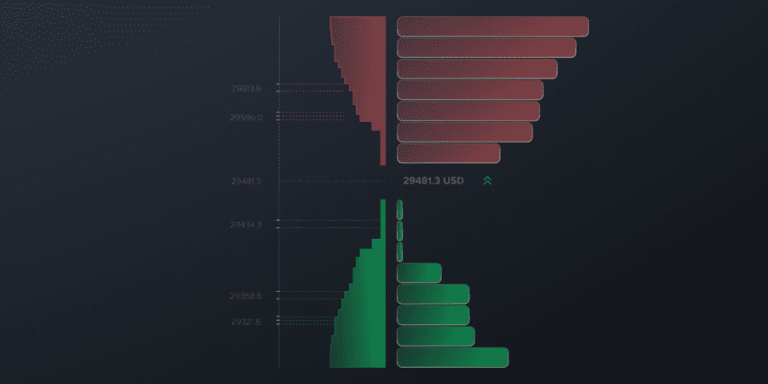
Ликвидность на рынке Форекс означает лёгкость, с которой валюту можно быстро купить или продать, не вызывая значительных колебаний цен. Она является жизненно важным фактором рынка Форекс, обеспечивающим эффективное исполнение сделок. Высокая ликвидность указывает на стабильность рынка с большими объёмами торговой активности, в то время как низкая ликвидность может привести к волатильным колебаниям цен.
Участники рынка в экосистеме Форекс
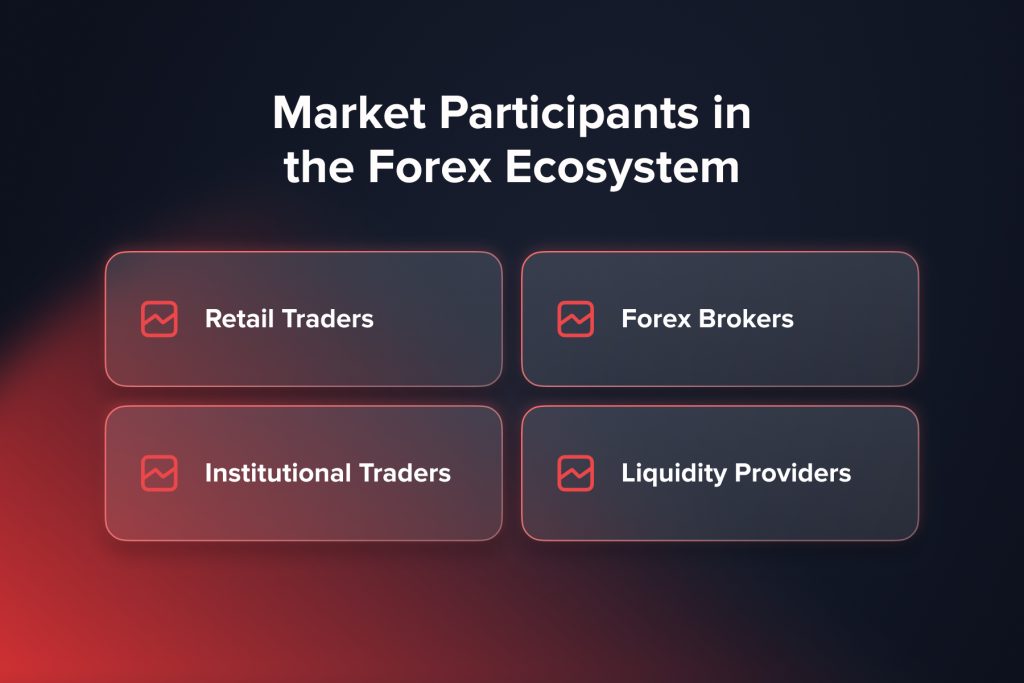
- Розничные торговцы: Частные инвесторы, торгующие на Форексе с целью получения прибыли или хеджирования. Им необходима постоянная ликвидность для размещения заказов по конкурентоспособным ценам.
- Институциональные трейдеры: Крупные коммерческие банки, инвестиционные фонды и корпорации, торгующие огромными потоками ордеров. Их участие на рынке зависит от надежных поставщиков ликвидности.
- Форекс-брокеры: Компании, обеспечивающие торговлю, связывая клиентов с межбанковским рынком. Они сотрудничают с поставщиками ликвидности для обеспечения ликвидности и ценообразования.
- Поставщики ликвидности: Это специализированные банки и независимые маркет-мейкеры, размещающие ордера на покупку и продажу различных валют. Они обеспечивают достаточный объём на рынке для исполнения сделок. Они поддерживают стабильную ликвидность для всех остальных участников.
Что такое поставщик ликвидности на рынке Форекс?
Поставщики ликвидности на рынке Форекс, часто называемые «маркет-мейкерами», обеспечивают непрерывный поток ордеров на покупку и продажу на рынке Форекс. Поставщик ликвидности — это участник рынка, который всегда готов купить или продать валютные пары в любой момент времени, предоставляя двусторонние цены. Они обеспечивают ликвидацию разрыва между участниками рынка, гарантируя наличие контрагента для каждой сделки.
Поставщики ликвидности Форекс делятся на два основных класса: маркет-мейкеры, которые используют свои балансы и ECN/STP Поставщики, специализирующиеся на технологическом сопоставлении ордеров. В то время как маркет-мейкеры предоставляют котировки как на покупку, так и на продажу и часто занимают противоположную сторону сделки, поставщики ECN (электронной сети связи) и STP (сквозной обработки) выступают посредниками, соединяя трейдеров с источниками ликвидности без необходимости открывать позиции самостоятельно.
Основные функции поставщиков ликвидности
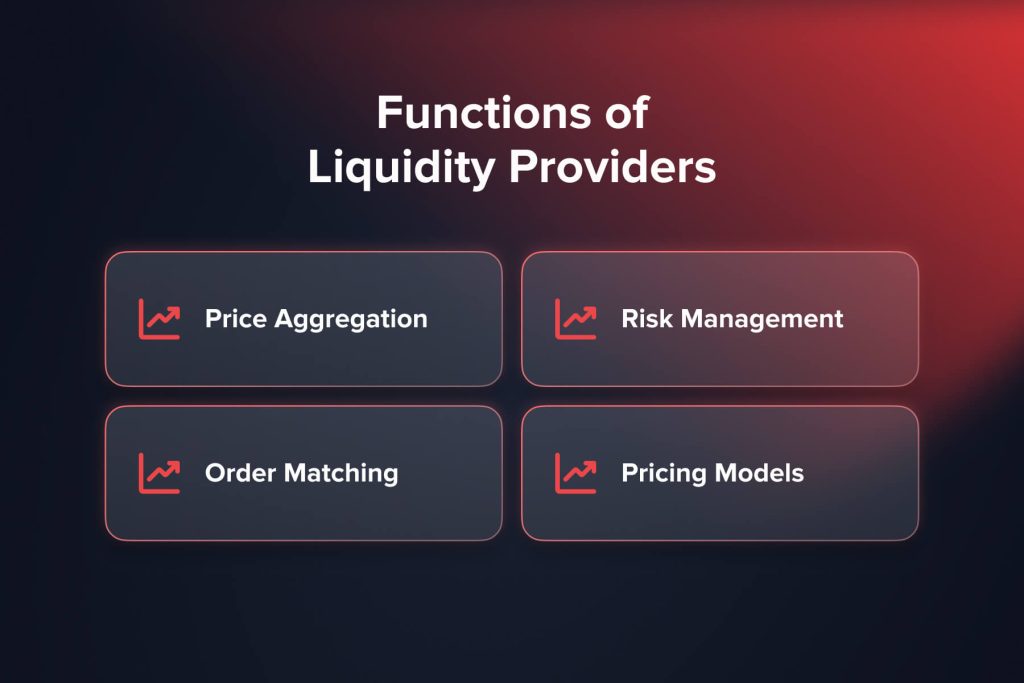
- Агрегация цен: Они собирают актуальные данные о ценах от банков, брокеров и торговых платформ для определения конкурентоспособных базовых ставок.
- Сопоставление заказов: Поставщики ликвидности сопоставляют ордера на покупку/продажу от различных участников рынка, чтобы облегчить торговлю и сократить спреды.
- Управление рисками: Сложные методы, такие как хеджирование, помогают им сохранять равновесие при колебаниях валютных курсов, обеспечивая при этом ликвидность.
- Модели ценообразования: Модели учитывают затраты, риски и рыночные условия, предлагая постоянно обновляемые цены спроса и предложения по всем валютам.
Эффективно выполняя эти основные функции, поставщики ликвидности могут поддерживать глубокие пулы ликвидности для бесперебойной и эффективной торговли на рынке Форекс.
Как работают поставщики ликвидности на рынке Форекс?
Рынок Форекс функционирует через сеть пулов ликвидности, наиболее значимым из которых является «Межбанковский рынок». Этот рынок объединяет крупнейшие мировые банки и финансовые учреждения, ежедневно торгующие огромными объёмами валют.
Основным пулом ликвидности является глобальный межбанковский рынок крупных банков и финансовых учреждений, торгующих огромными потоками ордеров.
Ликвидность на рынке Форекс часто подразделяют на два уровня:
- Уровень 1: В эту группу входят такие крупные международные банки, как Morgan Stanley, Goldman Sachs и Barclays. Они предлагают высочайший уровень ликвидности и являются основным источником большинства операций на рынке Форекс.
- Уровень 2: К ним относятся небольшие банки, финансовые учреждения и поставщики ликвидности, выступающие посредниками между брокерами и организациями первого уровня. Примеры включают FXCM Pro, CFH Clearing, LMAX Exchange, Refinitiv FXall, Currenex, Integral и Swissquote.
Поставщики ликвидности получают ценообразование и ликвидность с этих уровней и формируют свои пулы, доступные другим организациям. Многоуровневые модели помогают обеспечить каскадное распределение ликвидности от крупных банковских клиентов к более мелким брокерам и конечным пользователям.
Механизм обеспечения ликвидности
Современные технологии произвели революцию в обеспечении ликвидности на рынке Форекс. Такие инструменты, как мосты ликвидности и агрегаторы, обеспечивают брокерам быстрый доступ к лучшим ценам от различных поставщиков ликвидности. Они помогают собирать данные о днях проверки и крупные потоки ордеров с разных уровней.
Передовые программные решения и электронные коммуникационные сети (ECN) играют ключевую роль в обеспечении бесперебойного предоставления ликвидности. Эти технологии обеспечивают быстрое исполнение ордеров и агрегацию цен, улучшая общий торговый опыт. Развитые торговые платформы и инфраструктура непрерывно опрашивают поступающую ликвидность, анализируют рыночные условия и формируют индивидуальные цены.
Процесс исполнения заказа
В случае рыночных ордеров поставщики ликвидности сопоставляют ордера внутри компании или за её пределами и подтверждают исполнение как можно быстрее. Лимитные ордера сопоставляются при достижении лимитной цены, что требует от поставщиков ликвидности поддержания значительных портфелей ордеров.
Проскальзывание — это разница между ожидаемой ценой и ценой исполнения. Оно возникает, когда волатильность приводит к изменению обменных курсов между размещением ордера и его исполнением. Провайдеры минимизируют это, используя узкий спред, поскольку это может существенно повлиять на результаты торговли.
Используя технологии, связи и финансовые ресурсы, поставщики ликвидности поддерживают бесперебойный поток валютной торговли по всему миру.
Взаимоотношения между поставщиками ликвидности и форекс-брокерами
Поставщики ликвидности и брокеры тесно связаны. Брокеры полагаются на поставщиков ликвидности для обеспечения бесперебойного исполнения ордеров своих клиентов, в то время как поставщики ликвидности получают выгоду от объёма торгов, обеспечиваемого брокерами. Такие отношения строятся на доверии, и поставщики стремятся к прозрачному и справедливому отношению к брокерам и клиентам.
Преимущества использования поставщика ликвидности Форекс
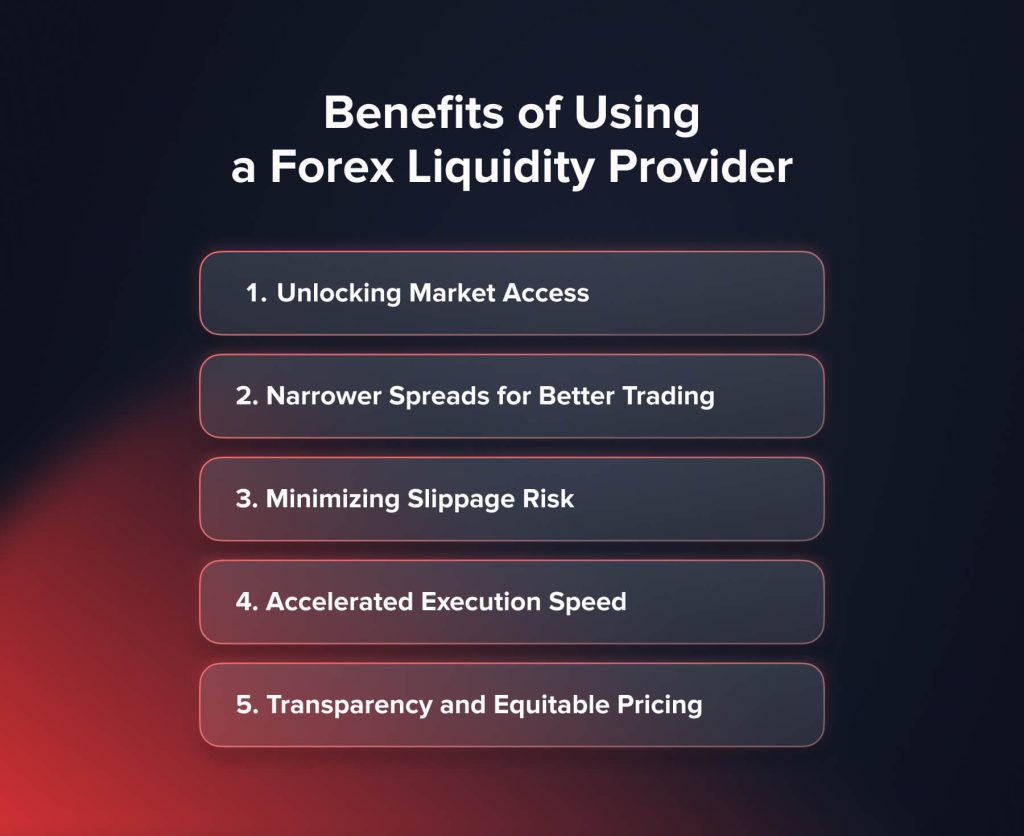
1. Открытие доступа к рынку
Благодаря поставщикам ликвидности трейдеры получают доступ к более широкому рынку, обеспечивая себе возможность торговать различными валютными парами. Благодаря их обширным сетям и книгам заказов трейдеры также получают доступ к валютным парам, которые в противном случае имели бы низкую ликвидность.
2. Более узкие спреды для лучшей торговли
Поддерживая конкурентоспособные цены покупки и продажи, поставщики ликвидности обеспечивают более узкие спреды между ценами спроса и предложения. Это приводит к снижению торговых издержек. Высокая ликвидность часто приводит к более узким спредам, что снижает торговые издержки.
3. Минимизация риска проскальзывания
Жесткие цены и большие размеры ордеров позволяют исполнять ордера по заявленным ценам, а не снижать их до менее выгодных уровней из-за волатильности. Высокая ликвидность снижает вероятность значительного проскальзывания.
4. Ускоренная скорость выполнения
Современная технологическая инфраструктура обеспечивает сверхбыстрое сопоставление и подтверждение заказов, предотвращая задержки, влияющие на торговые стратегии Сделки совершаются оперативно, что гарантирует трейдерам максимально выгодные цены.
5. Прозрачность и справедливое ценообразование
Трейдеры получают справедливый доступ и стабильные цены независимо от размера ордера, без каких-либо грабительских практик, таких как скрытые реквоты. Поставщики ликвидности предлагают прозрачные модели ценообразования, гарантируя справедливые условия торговли.
Проблемы и риски использования поставщика ликвидности на рынке Форекс
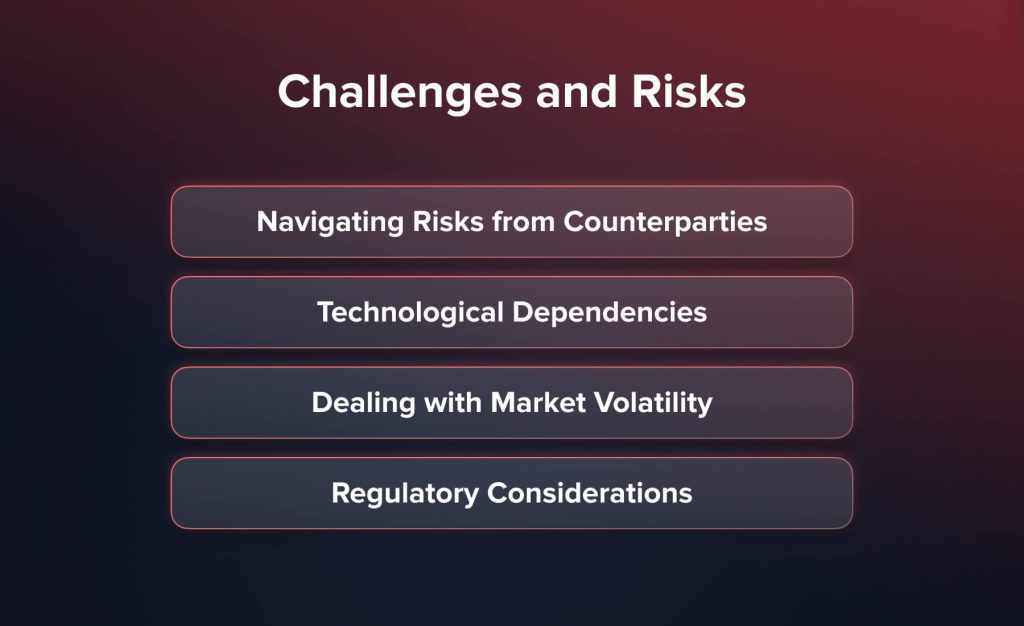
1. Управление рисками, связанными с контрагентами
Поставщики ликвидности не работают изолированно; они полагаются на дополнительные субъекты рынка для получения ликвидности. Эта взаимосвязь подвергает их ряду рисков, связанных, главным образом, с надёжностью их контрагентов. Поскольку они зависят от других субъектов рынка в качестве источника ликвидности, это подвергает их рискам в случае невыполнения обязательств или невыполнения обязательств этими контрагентами.
В основе каждой финансовой транзакции лежит концепция контрагентского риска. Эта концепция проистекает из зависимости от выполнения другой стороной своих обязательств в сделке. Это неотъемлемая черта финансовых рынков, где в транзакциях участвует множество контрагентов, каждый из которых обладает разной степенью финансовой устойчивости и надежности. Поэтому для финансовых провайдеров (FLP) постоянно присутствует тёмное облако контрагентского риска.
2. Технологические зависимости
Современный рынок Форекс в значительной степени зависит от сложных автоматизированных систем. Эти системы незаменимы для заключения сделок, управления портфелями и обеспечения эффективного ценообразования. Однако их сложность делает их уязвимыми к техническим сбоям и кибератакам. В эпоху, когда цифровые технологии стали нормой, финансовым провайдерам приходится противостоять угрозе технологических сбоев.
Эти сбои могут принимать различные формы: от сбоев в работе системы, приводящих к остановке торгов, до кибератак, манипулирующих ценами или повреждающих конфиденциальные данные. Последствия таких инцидентов могут быть серьёзными, включая финансовые потери и ущерб репутации. Поэтому поставщикам ликвидности необходимо найти тонкий баланс между максимизацией эффективности технологий и противодействием угрозам, связанным с технологическими уязвимостями.
3. Борьба с волатильностью рынка
Рынок Форекс известен своей внутренней волатильностью. Колебания цен — обычное явление, обусловленное множеством факторов: от экономических событий до геополитических тенденций и рыночных настроений. Когда волатильность резко возрастает, спекулянты, работающие на рынке Форекс, сталкиваются с серьёзными трудностями в поддержании необходимого уровня ликвидности и узких спредов.
Высокая волатильность сама по себе может нарушить рыночное равновесие, приводя к хаотичным колебаниям цен и разрывам ликвидности. Это неизбежно приводит к увеличению транзакционных издержек и большей неопределенности для поставщиков ликвидности. Умение ориентироваться и адаптироваться к меняющимся рыночным условиям — важный навык для любого, кто работает на рынке Форекс.
4. Нормативные соображения
Финансовый рынок Форекс регулируется целым рядом правил, призванных поддерживать целостность рынка и защищать инвесторов. Эти правила, хотя и необходимы, создают определенные трудности для поставщиков ликвидности. Более строгие правила часто приводят к росту операционных расходов, поскольку компаниям приходится выделять ресурсы для обеспечения соответствия требованиям.
Более того, нарушение нормативных требований может иметь серьёзные последствия: от санкций и штрафов до ущерба репутации и даже отзыва лицензий. В условиях постоянно меняющегося регулирования поставщики ликвидности должны сохранять бдительность и способность адаптироваться, будучи в курсе изменений, чтобы избежать дорогостоящих ошибок в соблюдении требований.
Как выбрать подходящего поставщика ликвидности на рынке Форекс?
При выборе подходящего поставщика ликвидности для Форекс, отвечающего вашим потребностям, следует учитывать ряд факторов. Каждый из них необходимо учитывать в совокупности с другими, прежде чем сделать окончательный вывод.
1. Репутация и надежность
Репутация провайдера красноречиво свидетельствует о его надежности. Это фундамент, на котором строится доверие и строить эффективные деловые отношения. Долголетие на рынке также является важным фактором при выборе поставщика ликвидности для Форекс. Эти характеристики помогут вам обрести уверенность и обеспечить стабильность в периоды нестабильности.
2. Глубина ликвидности
Глубина ликвидности провайдера связана с устойчивостью денежного обращения, также известной как финансовая стабильность. Это способность провайдера гарантировать своевременное и эффективное выполнение своих обещаний клиентам. Уровень предлагаемой ликвидности также может влиять на эффективность бизнеса и ценообразование. Провайдер, демонстрирующий высокую глубину ликвидности по нескольким валютным парам, гарантирует надежное выполнение требований по исполнению сделок.
3. Торговые издержки
Понимание структуры расходов вашего провайдера критически важно для обеспечения прибыльной торговли. Конкурентоспособные цены благодаря узким спредам необходимы для избежания скрытых комиссий и сборов.
4. Технологии и инфраструктура
Выбирая поставщика ликвидности для Форекс, необходимо быть знакомым с технологиями и инфраструктурой, которыми располагает этот поставщик. Современные и эффективные технологии важны для бесперебойной торговли. Чтобы поставщик ликвидности оправдал ваше внимание, он должен быть хорошо оснащён и обеспечивать оптимальные результаты.
5. Соблюдение нормативных требований
Вы не хотите попасть под прицел регулирующих органов, работая с поставщиком, не соблюдающим требования. Поэтому убедитесь, что ваш поставщик неукоснительно соблюдает все нормативные требования. Это также должно быть подкреплено надлежащими документами. лицензирование в основных юрисдикциях для легитимности и безопасности капитала.
Важность комплексной проверки и тщательного исследования
Прежде чем выбрать поставщика ликвидности, необходимо провести тщательное исследование, получить рекомендации и даже протестировать его услуги для оценки их эффективности. После рассмотрения всех вышеперечисленных факторов, вам нужно сделать ещё несколько шагов, чтобы убедиться в правильности своего выбора.
Тщательно оцените отзывы общественности, информацию о кредитоспособности, местоположение, партнёрские отношения и регулирующий надзор. Это даст вам более чёткое представление о том, чего ожидать от потенциального поставщика услуг, прежде чем принять решение. Вы узнаете о возможных рисках и о поставщиках, которых следует избегать.
Также проверьте такие независимые показатели, как средние спреды, скорость исполнения заявок и время безотказной работы платформы. Это поможет вам проверить некоторые заявления потенциального поставщика и убедиться в его надежности. Прежде чем принимать на себя обязательства, учитывайте потребности, основанные на стилях торговли, частоте, валютах и объёмах.
Выбор поставщика ликвидности важен для комфортной торговли и снижения рисков. Необходимо уделить время отбору поставщиков, чтобы найти оптимальное сочетание стоимости, надежности и поддержки.
Будущие тенденции в предоставлении ликвидности на рынке Форекс
Рынок Форекс постоянно развивается, его будущее определяется технологическими усовершенствованиями и изменениями в регулировании. Развивающиеся технологии уже рисуют весьма обнадеживающую картину будущего предоставления ликвидности на Форекс. Такие достижения, как торговля с малой задержкой, искусственный интеллект и дополненная аналитика, будут способствовать развитию моделей ценообразования и возможностей сопоставления ордеров.
Изменения в регулировании также сыграют важную роль в будущем предоставлении ликвидности на рынке Форекс. Во всем мире ужесточаются правила, касающиеся сегрегации клиентов, отчетности по транзакциям и мониторинга злоупотреблений на рынке. Это, безусловно, существенно повлияет на деятельность и должно быть учтено должным образом.
Развитие криптовалют и блокчейн-технологий обещает привести к значительным изменениям в способах предоставления ликвидности. Цифровые валюты и технологии распределённого реестра могут открыть новые возможности для предоставления ликвидности и обеспечения взаимосвязи на рынках в ближайшие годы.
В целом, ландшафт предоставления ликвидности продолжит меняться в соответствии с технологическими изменениями и меняющимися потребностями участников. Дальновидные поставщики, инвестирующие в инновации, будут лучше подготовлены к эффективной адаптации.
Заключение
Пространство Торговля на Форекс Сложная система, в основе которой лежит ликвидность. ФЛП играют незаменимую роль в обеспечении бесперебойной работы рынка, сокращая разрыв между покупателями и продавцами. Поддерживая огромные запасы ликвидности с помощью сложных технологических платформ, эти невидимые участники рынка являются спасательным кругом для всех форекс-трейдеров.
В процессе освоения сложностей рынка Форекс понимание роли и значения этих поставщиков становится первостепенным. Обладая этими знаниями, трейдеры могут легко принимать обоснованные решения, обеспечивая прибыльную и бесперебойную торговлю.
Обновлено:
18 декабря 2024 г.



